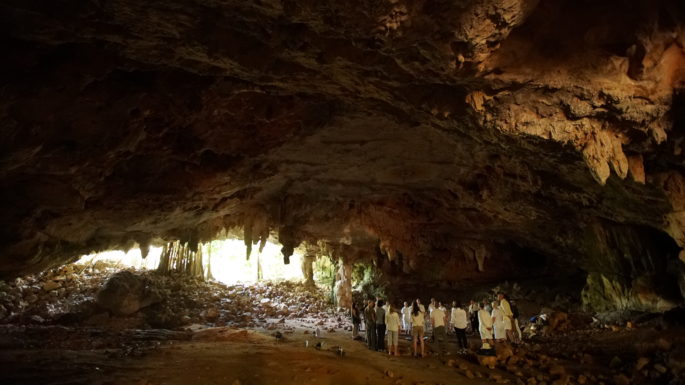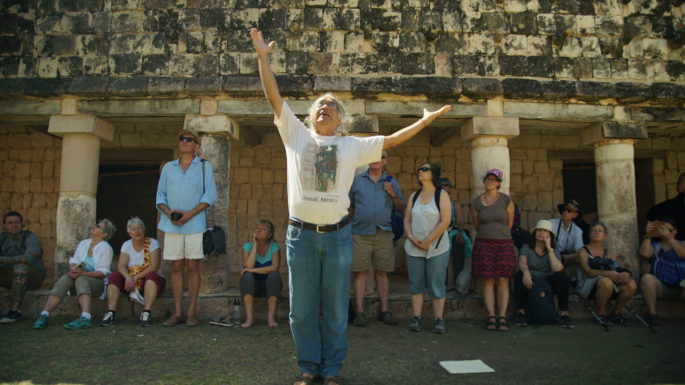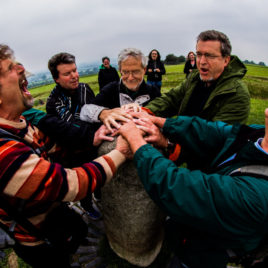
“The Maya Masters of Light studied deeply the mysteries of the infinite cosmos. In the eyes of the Jaguar they saw the light of creation. In the flight of the Feathered Serpent they created the calendars representing space, time, and movement. Science in union with the heart, technology in union with intuition.” -Miguel Angel Vergara, Maya Master Teacher and leader of Maya Temples of Transformation
As leaders of sacred travel and ceremony in the land of the ancient Maya, we follow closely the conversation surrounding Mayan ceremonial history. There’s a consensus among researchers of Mayan civilization, civilization of the Jaguar of hidden knowledge and the Serpent of initiation and wisdom, that the Maya didn’t begin their transformational ceremonies until between 350 B.C. and 250 B.C.
A groundbreaking finding made by the University of Arizona’s Middle Usumacinta Archaeological Project, however, is suggesting sedentarism and ceremonial life began centuries earlier among the Maya. Early last month, on 03 June 2020, the Project published findings in Nature of “airborne lidar survey and excavations of the previously unknown site of Aguada Fénix (Tabasco, Mexico) with an artificial plateau, which measures 1,400 m in length and 10 to 15 m in height and has 9 causeways radiating out from it.” Even more remarkable are the results of Bayesian radioactive dating taken from 69 samples. The samples reveal this largest ceremonial site found to date to be constructed between 1,000 B.C. and 800 B.C.
In 2017, professor Takeshi Inomata and his team took to aircraft over Tabasco, Mexico to capture a LiDAR survey of a lightly forested cattle ranch. The LiDAR technology utilized by his team involves laser technology capable of capturing structures hidden beneath thick forest and shrubbery. They found beneath the cattle ranch the structural remains of what was hidden for perhaps millennia: Aguada Fénix, the largest Mayan ceremonial site known to date.
Ancient Maya and Community

Similarities between Aguada Fénix and the Olmec site of San Lorenzo in Guatemala made the team question the newly discovered site’s origin. After years of investigation, Inomata and his team were able to identify Aguada Fénix, unlike the Olmec site, as a communally built and sustained (rather than hierarchical) site. The discovery places emphasis on the collective intentions of the origins of the Maya, particularly in terms of their ceremonial origins.
The importance of ceremony to the Maya is being increasingly revealed to the point where we believe it had much to do with the beginning of sedentarism among the Maya. Though much older and less preserved, we can imagine Aguada Fénix being categorized with the most important ceremonial Mayan cities in Mexico including Uxmal and Chichen Itza, both of which we’ll be seeing during our journey through the sacred Mayan temples of Mexico’s Yucatán.
According to legend, Uxmal was a cosmic city that descended from the fourth dimension to amaze the eyes of humankind. This is a fabulous temple city boasting several pyramids and sacred plazas with highly decorated façades. It is said the people of Uxmal developed a great sense of intuitive skills, gaining a high level of spirituality in their lives. Beauty, poetry, dance, and the other arts were developed here.
In the meantime, we have Chichen Itza, likely the most renowned Mayan city in modern times. According to modern Mayan wisdom keepers, Chichen Itza is the cosmic university where one connects with the science, art, philosophy and spirituality of the Maya. It is said this ancient school attracted students, initiates, and teachers from all over the Maya world.
Resurrecting Traditions

In years to come, what will we know of Aguada Fénix? What’s known so far about the primary intentions behind such a grand ceremonial complex? The study’s coauthor, Verónica Vázquez López, observed that differing soils displayed in square patterns were used to build the site’s foundational platform. This tells us that various groups may have contributed to building Aguada Fénix.
With discoveries being made showing the Maya to be more ancient and ceremonial based than previously thought, there’s no better time to explore these people and lands, especially with trusty guides and scholars. In the words of our other Maya Temples of Transformation guide Freddy Silva: “What we try to do is get back to the actual indigenous teachings of local temples. We’re actually getting back to the mindsets of the people who originally built the sites. There’s a meaning to these places.” And in the words of Miguel Angel Vergara: “We are in a time to enjoy the sacred knowledge, to enjoy what is in the temples and the pyramids because their purpose is one—to help us become ourselves, better human beings, to become ourselves and better servers of humanity.”
When Takeshi Inomata of the University of Arizona’s Middle Usumacinta Archaeological Project saw Aguada Fénix, according to National Geographic, he and his team saw it as a city of processions and rituals they could only imagine. Fortunately, we currently have guides, elders, and wisdom keepers who are studying for years to bring the rituals and traditions back to life.

